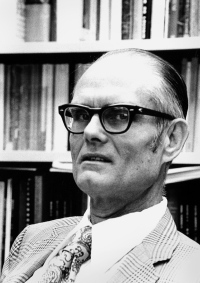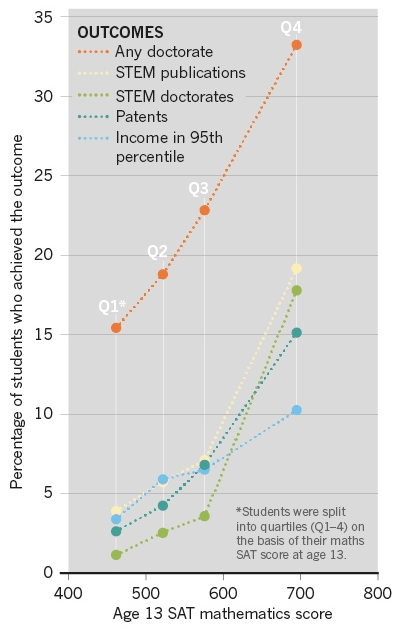45-year study of the life successes of geeks

Many of the children whose results were included in the top 1% of the country in the mathematical section of the SAT, have achieved some success in adulthood. In the photos - three of those who went through the Hopkins Center for Gifted Children in the 1980s and 1990s. The
45th year of the long-term experiment SMPY (Study of Mathematically Precocious Youth) went. For almost half a century, scientists have carefully studied and documented the achievements of 5,000 people who, at a young age, showed the highest marks in a mathematical test.
“Whether you like it or not, these people really control our society,” saysJonathan Wai, a psychologist from the Duke University Young Talent Program. “The guys who are in the top 1% in math test, as a rule, become outstanding scientists and academics, leaders of major corporations, federal judges, senators and billionaires.” Of course, we are talking about the United States, where the social elevator works well.
 Professor Julian Stanley (Julian Stanley, pictured) from Johns Hopkins University began his long-term study in March 1972. To begin with, he selected 450 smart kids aged 12-14 years old, who showed the best results in the mathematical part of the SAT test - a standardized test for admission to universities in the United States.
Professor Julian Stanley (Julian Stanley, pictured) from Johns Hopkins University began his long-term study in March 1972. To begin with, he selected 450 smart kids aged 12-14 years old, who showed the best results in the mathematical part of the SAT test - a standardized test for admission to universities in the United States. The three-part mathematical section of the SAT is known as the Quantitative Section (Calculation Section). The 70-minute test includes mathematical analysis and work with graphs. In the first part - 20 questions; in the second - 8 questions with a choice of the answer and 10 questions with a field for the complete writing of the answer; in the third part - 16 questions ( examples of questions from the mathematical part of the SAT ).
According to the journal NatureThis was the first standardized search for talent in the country. Previous similar studies on the life fate of children with high IQ were stopped after several children, who were rejected for insufficiently high IQ as a child, later won the Nobel Prize (for example, the inventor of the transistor William Shockley IQ 129). It became clear that the level of IQ is not very well correlated with success. As it turned out, the SAT math test gives a much better correlation. However, there is an even more accurate method (about it below).
Five years after testing the first children, Professor Stanley expanded the sample and began to track the further fate of children: from graduation to university and moving up the career ladder.
Gradually, new groups of children were added to the sample, and with the fifth group in 1992, their total number reached 5,000. According to the testing methodology, further studies were planned when 12–14-year-old children from the first four groups reached the age of 18, 23, 33, 50, and 65 years. For the last fifth group, age markers of 35, 50 and 65 years were established.
This is probably the most extensive and thorough study of the fate of young talents in the world. Its results will upset parents whose children do not have an outstanding mind. Unfortunately, it will be much more difficult for them to get into the elite.
As in the case of athletes, the results are more likely to refute the myth that long workouts (10,000 hours or more)will allow absolutely any mediocre person to achieve outstanding results in the chosen case and become the best. This is not true. Natural ability is much more important than hard work and training. This applies to sports and scientific activities. Congenital abilities are not only the main success factor in research, but also the only reliable indicator that allows you to predict future success.
Now, when the first groups of gifted children have reached the peak of their careers, it has become quite obvious how much these children exceed the average indicators in their achievements. Among those children who entered the 1% of the best American children on the SAT test were the outstanding mathematicians Terence Tao and Lenard Eun., Facebook founder Mark Zuckerberg, Google founder Sergey Brin, musician Stephanie Germanotta (Lady Gaga). They all passed through the Hopkins center for gifted children.

The graph shows that the probability of obtaining a doctoral degree, publish a scientific work, obtain a patent or a high cash income in the United States correlates with the result of the SAT mathematical test at the age of 13. Source: K. Ferriman Robertson et al. Curr. Dir. Psychol. Sci. 19, 346–351 (2010)
However, only American parents will be very upset about difficult life prospects. In less developed countries, intelligence is not so much a determining factor in moving up the social scale. This increases the chances of mediocre, but purposeful and hardworking children from richer families with connections to rise to the highest positions.
Oddly enough, but the authors of the study point out an interesting phenomenon in the school system. It turns out that gifted children may be at a disadvantage in the education system, which focuses on lagging and mediocre children. Judging by the results, the best results are achieved by those gifted children who are transferred immediately through two classes upwards or who are given premature access to university educational materials.
For example, among gifted children who were transferred through two classes (for example, from the 8th to the 10th at once), 60% more likely to get a doctoral degree or patent than those gifted children who moved progressively in classes instead of with the rest .
The authors of the study explain that there is no special treatment for gifted children. They just need to give older textbooks. At the same time, psychologists recommend avoiding classifying children into “gifted” and “ungifted”, since it can reduce the motivation of children to make efforts to study.
According to the results of a 45-year SMPY study, more than 400 scientific papers were published.and a lot of interesting conclusions. Researchers have traced many features and curious correlations that accompany mathematically gifted children. One detail stands out among them. The best results in the number of obtained patents and scientific papers that have passed a peer-review are shown by those who showed the maximum result in tests for visual-figurative thinking , that is, the ability to manipulate two-, three- and four-dimensional objects in mind. Success in this particular test gives a better correlation with future achievements than success in a simple SAT math test.
And who were your talented classmates who knew mathematics better than anyone? Are among them billionaires and senators?
